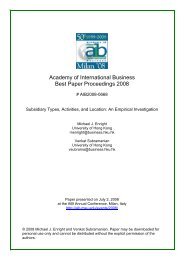AIB 2012 Conference Proceedings - Academy of International ...
AIB 2012 Conference Proceedings - Academy of International ...
AIB 2012 Conference Proceedings - Academy of International ...
Create successful ePaper yourself
Turn your PDF publications into a flip-book with our unique Google optimized e-Paper software.
MONDAY<br />
India, China, and South Africa). Institutional regimes evolve rapidly to support such activities, and indigenous<br />
firms are re-engineering their search routines to enhance their R&D and shift it to riskier domains. Multinational<br />
R&D has broken <strong>of</strong>f their well-tested routines <strong>of</strong> restricting R&D to home or home-like markets and investing<br />
significantly in emerging markets. So much so, these markets are redefining MNE strategies and products. This<br />
panel will address questions such as the motivation and rationale for such investment; its geographical and<br />
sectoral spread; and its interaction with the local innovation system. All these questions will be answered in a<br />
dynamic context and the changes over time will be identified and placed in a strong theoretical context. This<br />
panel is expected to generate rich insights into the changing nature <strong>of</strong> multinational R&D in emerging markets<br />
by taking a focused look at India, with important implications for theory and practice. (For more information,<br />
please contact: Rishikesha T. Krishnan, Indian Institute <strong>of</strong> Management Bangalore, India: rishi@iimb.ac.in)<br />
Session: 2.2.4 - Competitive<br />
Track: 7 - Emerging Economies<br />
The Nature <strong>of</strong> Innovation in Emerging Markets<br />
Presented On: July 2, <strong>2012</strong> - 10:45-12:00<br />
Chair: Masaaki Kotabe , Temple University<br />
Transcending Paradoxes: Managing Innovation and Growth in the Indian Biotech Industry<br />
Shaista E. Khilji, George Washington University<br />
Tomasz Mroczkowski, American University<br />
Rashmi Assudani, Xavier University<br />
Biotech companies in USA are generally faced with the paradoxes <strong>of</strong> simultaneously managing growth and<br />
innovation, as well as addressing explorative and exploitative aspects <strong>of</strong> innovation (Khilji, Mroczkowski &<br />
Bernstein, 2006). This has led to a high failure rate among them. Scholars have urged tem to re-evaluate their<br />
business model (Pisano, 2006). With the purpose <strong>of</strong> exploring how biotech companies in emerging economies<br />
address these paradoxes, we focus upon the nascent biotech industry in India in order to investigate their<br />
growth and innovation patterns, as well identify the challenges that they may be faced with. Data indicates that<br />
Indian biotech companies are ambidextrous and have managed to transcend the aforementioned paradoxes by<br />
developing and maintaining distinct organizational capabilities. They were found to pursue an integrated model<br />
<strong>of</strong> efficiency and innovation and utilize both exploitative and explorative aspects <strong>of</strong> innovation to fuel growth<br />
and innovation. We also find evidence <strong>of</strong> some <strong>of</strong> the characteristics <strong>of</strong> the "India Way", proposed by Cappelli,<br />
Singh, Singh & Useem (2010a). We conclude that American biotech companies could glean some <strong>of</strong> the learning<br />
from their Indian counterparts in order to build new competencies and sustain innovation in today's competitive<br />
environment. (For more information, please contact: Shaista E. Khilji, George Washington University, USA:<br />
shaistakhilji@gmail.com)<br />
The Structure and Performance <strong>of</strong> Reverse-Innovating Subsidiaries in Emerging Markets<br />
Michael Sartor, University <strong>of</strong> Western Ontario<br />
This paper explores the structure and performance <strong>of</strong> foreign subsidiaries that employ a reverse innovation<br />
strategy – the process <strong>of</strong> entering into emerging markets for the purpose <strong>of</strong> engaging in research and<br />
development (R&D)-related activities. Given the well-documented risk <strong>of</strong> intellectual-property (IP) leakage in<br />
these markets, we investigate how normative institutions in the host country market shape the structure and<br />
performance <strong>of</strong> these unique investments. While institutional theory tends to predominate in research related to<br />
host market institutions, we build on conceptual advances in transaction cost economics (TCE) and the<br />
resource-based view (RBV) to develop a set <strong>of</strong> competing hypotheses with respect to the impact <strong>of</strong> two distinct<br />
types <strong>of</strong> normative institutional distance (governmental and technological) upon the ownership mode choice and<br />
<strong>AIB</strong> <strong>2012</strong> <strong>Conference</strong> <strong>Proceedings</strong><br />
Page 128

















